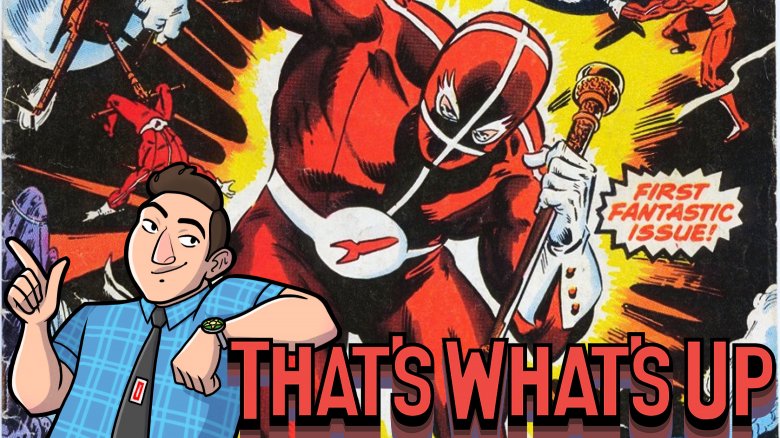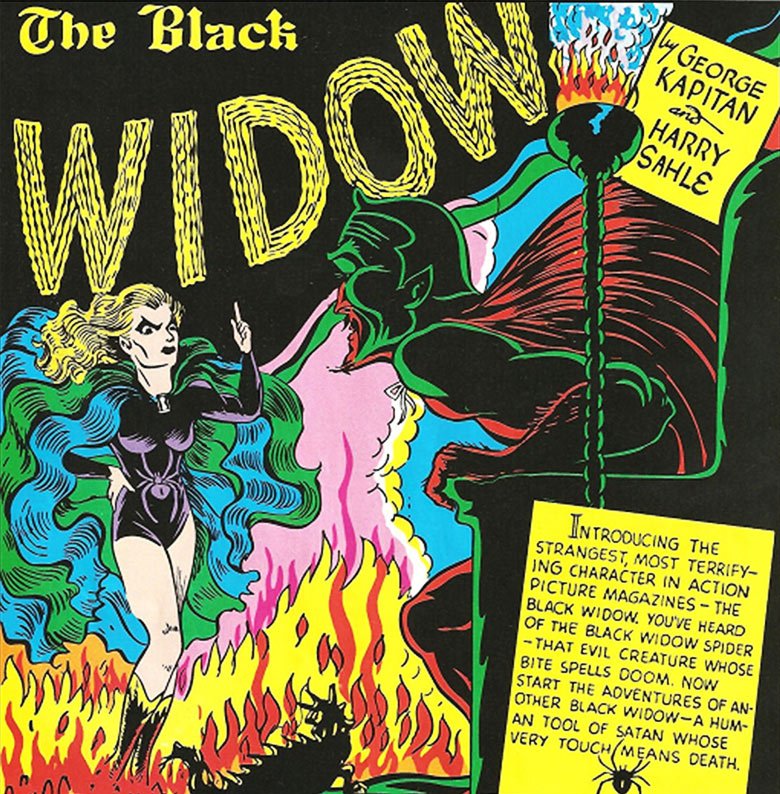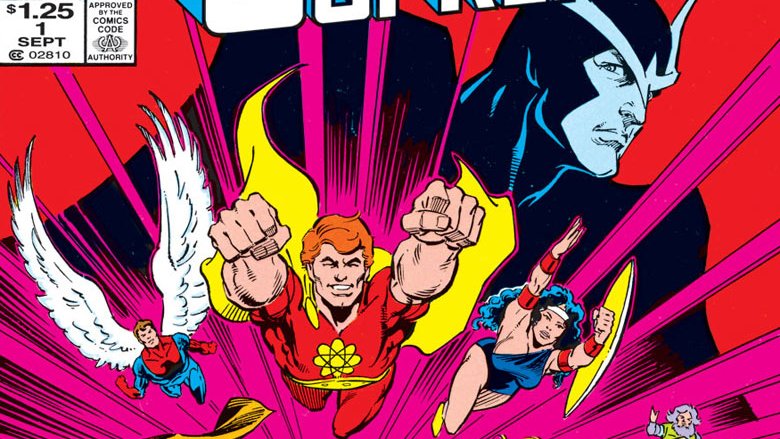That's What's Up: Marvel Characters You'll Never Ever See In The MCU
Each week, comic book writer Chris Sims answers the burning questions you have about the world of comics and pop culture: what's up with that? If you'd like to ask Chris a question, please send it to @theisb on Twitter with the hashtag #WhatsUpChris, or email it to staff@looper.com with the subject line "That's What's Up."
Q: I saw that there's a fight scene in Avengers: Infinity War that's supposed to have 40 superheroes involved. With that many heroes, are there any Marvel characters left that will never make the cut to be in the Marvel Cinematic Universe? — via email
Listen. Ten years ago, I would've rattled off a long list of characters that I didn't think would ever make it into the movies, but if the past decade has taught us anything, it's that nothing is off-limits when it comes to the MCU. I mean, Thor: Ragnarok had a cameo appearance by the Bi-Beast! We've had two movies about Ant-Man, and three with Rocket Raccoon — and one of those had Exitar the Exterminator in it! Heck, if you count the TV shows, there was an episode of Agents of S.H.I.E.L.D. that had someone reading the Darkhold! That's a deep cut even by my standards, and as you may already know, my standards run pretty deep as it is.
But even if the movies keep up the pace that we've seen in stuff like Spider-Man: Homecoming — which had the Shocker, the Tinkerer, the Prowler, the Vulture, the Scorpion and Damage Control — it's gonna be a long time before they get around to everyone. So with that in mind, here are my picks for the least likely characters to ever show up as cinematic Avengers... but that might just make their way in there anyway.
Pussycat: Agent of S.C.O.R.E.
Okay, this one is by far the most obvious choice. Considering her pedigree, you'd think Pussycat would be a no-brainer. She was created in 1968, at the height of the first Marvel Age of Comics, by no less a team than legendary artist Wally Wood and Stan Lee himself. The problem is that she wasn't a superhero. She was an attempt to bridge the gap between Marvel's comics and the other, more profitable division of Marvel's parent company: softcore "Men's Adventure" magazines with titles like Male.
The Adventures of Pussycat was a pretty straightforward parody of James Bond and The Man From Uncle with, to use Lee's own phrasing, a "nudie-cutie" twist. The title character was a ditzy, blonde, and improbably buxom secretary working for the Secret Council Of Ruthless Extroverts, which is the kind of acronym that makes you long for the subtlety of the Mental Organism Designed Only for Killing. Over the course of eight stories, Pussycat traipsed her way through S.C.O.R.E.'s conflict with L.U.S.T. (which didn't actually stand for anything) before disappearing from shelves forever. Despite some genuinely good art (think an extremely thirsty version of MAD Magazine and you're pretty close) and the star power of the creators involved (including Al Hartley, who drew one Pussycat story, promptly left Marvel became a born-again Christian, and then spent the rest of his career doing Jesus-themed Archie comics for a company called Spire), it's not exactly something that anyone's in a hurry to acknowledge.
But here's the thing: Pussycat actually does exist in the modern-day Marvel Universe. In their reality-warping, all-too-brief run on Defenders, Matt Fraction and Jamie McKelvie reintroduced the character as "Agent Pussycat." In that series — or at least the one issue of it that she appeared in — Pussycat was reimagined along the lines of a Bond girl as a sexy HYDRA super-assassin who tried to kill Nick Fury. If any version of the character is going to show up in the movies, it'll probably be that one, but that still seems like a pretty staggering long shot.
Elf With A Gun
Speaking of the Defenders, we have what might be that infamously weird team's most infamously weird antagonist.
If you've ever studied writing, you may have come across the bit of advice that the legendary author Raymond Chandler gave in an essay about hard-boiled detective fiction: "when in doubt, have a man come through the door with a gun in his hand." Back in the '70s, Steve Gerber, the writer whose strange sensibilities gave the world Howard the Duck, apparently decided that philosophy was in need of an upgrade. To spice things up during his run on Defenders, he would occasionally just cut away to an elf with a gun showing up somewhere, usually in an elaborate disguise, and murdering someone. Like, a Christmas elf. Little hat and everything.
To make matters even weirder, Gerber never really bothered to explain why any of this was happening. In an issue of Back Issue, he said that the entire reason for the Elf's creation was that artist Sal Buscema asked him to throw some variety into his scripts because he was tired of of drawing the same old Bronze Age supervillains all the time. Eventually, there was a story about how the Elf (and other identical Elves-With-Guns) were agents acting on behalf of the cosmic balance by enacting a ridiculously complicated plan that would keep the Defenders from destroying the universe, but even that was later revealed to be a hoax. It turns out that life in a world with superheroes is just weird sometimes.
But yeah, don't get me wrong: I would 100% love to see this guy show up in the modern Marvel movies — can you imagine how great it would be if the grim-and-gritty Netflix version of the Defenders just occasionally cut to some dude in a full-on Will Ferrell in his Elf costume just gunning someone down? — I just don't think it's likely to happen.
Oh, also, his name is Melf.
Stargod
This one requires a bit of specificity. To be perfectly clear, I don't think it's unlikely that we'll see Hero Astronaut John Jameson showing up in a movie. He's not in there yet, but the MCU's take on Spider-Man will inevitably involve America's Greatest Newspaperman, J. Jonah Jameson, and once you've got him, it's a pretty short road to get to having his son show up, too. Sony and Sam Raimi even already got him on the big screen once in Spider-Man 2.
I don't even think it's entirely unlikely that John's alter-ego, the Man-Wolf, will make it to the screen. In a world where M'Baku, who debuted in comics with one of the most unfortunate names of all time, is a universally beloved character in one of the highest-grossing movies of all time, you honestly never know when someone's going to decide to roll the dice on a blockbuster action movie where Spider-Man fights an astronaut who gets turned into a werewolf because of magic moon rocks.
Stargod, however, feels like a step or five too far. Not only is he an astronaut who got turned into a werewolf, he's an astronaut werewolf who traveled to another dimension so that he could fulfill a thousand year-old prophecy as a Conan-style sword and sorcery hero. Again: I would genuinely love to see that on the big screen in all its truly bizarre glory, and of everyone on this list, I think this one might actually be the closest one to happening. The MCU already has weird outer space Conan stuff thanks to Thor: Ragnarok, and since John Jameson's already made it to movies once, it's easy to believe he could do it again and follow his character to its completely illogical conclusion. That said, there's still a thin line between "possible" and "likely," even if getting Taserface in a major motion picture has all but obliterated it.
Golden Age Black Widow
If you dig back into Marvel's roster of Golden Age characters, you'll find plenty of strange characters who first cropped up during that big boom in the '40s who were mostly forgotten after Stan Lee and Jack Kirby created the Marvel Universe proper with the Fantastic Four in 1961. For every Captain America or Namor the Sub-Mariner who has managed to come back and endure all the way to the present, there's about a dozen other weirdos like the Vagabond — an FBI agent who disguises himself as a hobo clown to fight crime — or Rockman, the Underground Super-Agent, who has the ability to summon an army of subterranean elves to do his bidding.
Those characters aren't exactly bad, for the most part, but they're definitely so strange, even by the standards of superhero comics, that they'd have a hard time finding an audience. The original Black Widow, on the other hand, has one of the best and easiest-to-understand high concepts of any character, ever. She should absolutely be in a movie. She should probably be in every movie. She's an assassin who works for the devil.
Her name is, wait for it, Claire Voyant, and in life, she was a spirit medium with occasional correspondence to Hell who was murdered by one of her clients. Needless to say, she found herself before the devil upon her death, but rather than condemning her to eternal damnation, he decided to employ her to kill sinners before they could repent. Thus, she returned to Earth as an "ambassador of Satan" to murder the wicked with a death touch. That is an amazing premise, and I honestly don't know why she's not still around in some form.
That said, the MCU already has a Black Widow, and they probably don't want to confuse the brand by introducing a completely unrelated character with the same name. If, however, Dr. Strange is looking for an antagonist in a future installment of that franchise, Claire's right there.
Marvex the Super-Robot
She definitely has the best hook, but Claire Voyant isn't the only great but mostly forgotten Golden Age Marvel character... assuming you're willing to slightly adjust your definition of "great." My personal favorite of the also-rans? Marvex the Super-Robot, who debuted in Daring Mystery Comics #3, an issue that also featured Trojak the Tiger Man and the Phantom Reporter, whose civilian identity was probably pretty easy to guess given that he was running around in a mask while still telling everyone what his day job was.
Marvex was a robot created as a servant by a fifth dimensional scientist named Bolo, but upon activating, he decided that he wasn't really into the whole slavery thing. Instead, he killed Bolo, then picked his body up by the ankles and used him to beat all the other scientists to death before escaping to Earth. He then took up a career of fighting crime that mostly involved throwing dudes through cars and crashing face-first through windows, while also spending most of his debut story buying clothes and resisting the advances of an ersatz Lois Lane named Clara Crandall.
See, while he was absolutely a robot, Marvex had astonishingly lifelike features (including hair) that were just colored to be vaguely metallic. As a result, he looked like a handsome, albeit silver, man once he put on a suit, leading Clara to vaguely try forming a romantic relationship after Marvex saved her from gangsters, which was the Golden Age Comics equivalent of asking someone out for coffee. Sadly, she was rebuffed at the end of that story when Marvex told her, and I quote, "we can never be more than friends, because I am not human — I am Marvex the Super Robot." He then tore open his clothes on the street, with the caption reading "the super-robot quickly disrobes showing his metal body." It is unquestionably the high point of the medium, but might not play that well on a movie screen.
The Squadron Supreme
On paper, Mark Gruenwald and Bob Hall's Squadron Supreme seems like it would be one of the easiest comics to adapt to film. It's a self-contained story that deals with exactly the sort of "superheroes confronting realistic consequences of their actions" premise that audiences love. I firmly believe that from a storytelling standpoint, it's every bit as good as Watchmen, and that the only reason more people don't know that is that while Watchmen has consistently been in bookstores for the past 30 years, Squadron Supreme has been in and out of print.
Either way, it's a masterpiece, and if you've never read it, track it down immediately. It tells the story of a group of superheroes, previously introduced as enemies of the Avengers from another Earth in the Marvel multiverse, who decide that in the wake of a massive battle with supervillains, they can recreate the world as a utopia by using their powers to do more than just fight evil. With that in mind, they essentially take over, but it creates a schism within their ranks, and, of course, the Squadron's members have all too human flaws that their absolute power turns into absolute mistakes. It's a great, smartly told story, and while it definitely uses the language of superheroes, we've gotten to the point where superhero movies are so prominent that it's a language mass audiences can understand.
There's just one problem: the Squadron Supreme is Marvel's version of the Justice League.
Seriously, that's the entire point. Hyperion is an analogue for Superman, Nighthawk is Batman, Power Princess is Wonder Woman, and so on down the line. They filed the serial numbers off the competition's greatest characters so they could do an "Avengers vs. Justice League" style story without actually having to do a crossover, and Gruenwald, a lifelong DC fan who spent his entire career working at Marvel, ran with it and told the kind of story that could never actually be done with the JLA.
As amazing as it would be to see Marvel just straight up do a Justice League movie as an elaborate shot at Warner Bros., I have to imagine that someone in a legal department somewhere would see that idea and then immediately start screaming so loud their own eyeballs would explode.
The Human Fly
Finally, we have my absolute, guaranteed pick for a Marvel character who's never going to be one of the cinematic Avengers: the Human Fly, who starred in a short-lived series that ran from 1977 to 1978. Admittedly, this one's a bit of a cheat. Even though he firmly existed within the Marvel Universe while his comic was running and teamed up with Spider-Man, Ghost Rider, and others, the Human Fly was a licensed character — and to make to matters even more complicated, he was actually based on a real person.
That was actually a selling point for the comic. Each issue promised that readers would be getting the stories of "the wildest super-hero ever — because he's real!" And he was: the Human Fly was a daredevil stuntman who emerged at the height of an era where Evel Kneivel had become one of the most famous people in the world by jumping (and occasionally crashing) a rocket-powered motorcycle over various objects. What set the Fly apart, aside from the fact that he once attempted to jump 27 school buses at a Gloria Gaynor concert in Montreal, was that he went full superhero with his gimmick, to the point of even having a secret identity.
In reality, the Fly was a Canadian stuntman named Rick Rojatt, but he always wore a masked costume at his appearances, and took pains to keep his identity under wraps. He was so committed to it, in fact, that according to an article in Back Issue, when Marvel execs went to meet with the Human Fly to discuss the licensing for the comic, Rojatt introduced himself as the head of the Fly's crew before excusing himself and returning in full costume, claiming to be a different person entirely. The Marvel folks weren't fooled — it will not surprise you that people who spent their lives making superhero comics were pretty familiar with the concept of how secret identities work — but they liked it enough that they made his secret a big part of the comic, too. It fit right in, even if it's difficult to claim your hero is "real" when he's fighting supervillains alongside the extremely fictional Ghost Rider.
The good news is that at least as of 2012, there was a movie about Rojatt in development somewhere. The bad news, for our purposes at least, is that the combination of licensing rights, obscurity, and a premise that's completely bonkers even for comics in 1977 has kept The Human Fly from ever being reprinted, and will absolutely keep him out of the MCU. Still, I wish they could figure out a way to update that character for a new audience. Like, maybe they could get some other real-life daredevil to sign up for that sort of role. Can you imagine, say, Tony Hawk showing up in a luchador mask in the middle of Infinity War to McTwist over Thanos or something?
Oh dang. Now that I've actually thought about it, I want to see that more than I want oxygen to continue existing in my home.
Each week, comic book writer Chris Sims answers the burning questions you have about the world of comics and pop culture: what's up with that? If you'd like to ask Chris a question, please send it to @theisb on Twitter with the hashtag #WhatsUpChris, or email it to staff@looper.com with the subject line "That's What's Up."







